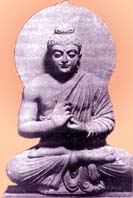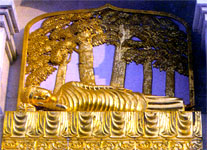|
|

|
|

|
Buddhism stands on three pillars: the Buddha; its founder, the Dhamma; his teachings and the Sangha; the order of Buddhist monks and nuns.
Siddhartha,
 who was
later known as the 'Buddha', the enlightened one, was the son of king Shuddhodana
of Kapilavastu and his queen, Maya. He was born in 563BC on the Vaisakha Purnima
day in the royal grove at Lumbini near Kapilavastu, Capital of the Sakyan republic.
His family name was Gautama and he belonged to the Shakya clan. Hence he is
sometimes called Shakyamuni (Shakya sage) or Shakyasimha (Shakya lion). Among
his other epithets are Amitabha (infinite light) and Thathagata ( he who
has arrived at perfection).
who was
later known as the 'Buddha', the enlightened one, was the son of king Shuddhodana
of Kapilavastu and his queen, Maya. He was born in 563BC on the Vaisakha Purnima
day in the royal grove at Lumbini near Kapilavastu, Capital of the Sakyan republic.
His family name was Gautama and he belonged to the Shakya clan. Hence he is
sometimes called Shakyamuni (Shakya sage) or Shakyasimha (Shakya lion). Among
his other epithets are Amitabha (infinite light) and Thathagata ( he who
has arrived at perfection).
Queen Maya died a week after delivering the prince. So the child was brought up by his step mother Gautami. At Siddharthas birth, the royal astrologer prophesied that he would one day become disillusioned with worldly pleasures and go forth as a mendicant in search of the wisdom that can overcome suffering.
The king, remembering the astrologers prophecy, tried to save his son from unpleasant sights. The king found for him a lovely wife, Yashodhara. Yashodhara bore him a son. He named his son Rahula (impediment). But the seeds of disenchantment had already sprouted in Siddhartha's heart.
As prophesied, Siddhartha
saw the three signs of suffering: sickness, old age and death. These
sufferings touched his heart and he left his palace on the night of the full moon in
the month of Vaisakha, at the age of 29, to seek mental peace in the homeless
life of an ascetic.
With a view to finding a true solution, the Buddha endeavored for full six years. During this period, he searched, scrutinized and examined in detail the prevalent schools of thought. He realised that wisdom could not be attained through self-mortification. At last, meditating under a tree near Gaya, he attained Bodhi (Illumination). Prince Siddhartha became the 'Buddha', the fully awakened one and the tree which had sheltered him came to be known as the bodhi tree.
After becoming enlightened,
Gautama the Buddha could have immediately realised himself from the cycle
of rebirths and attained 'Nirvana'; supreme liberation. But he decided to share his
wisdom with others. His first sermon was preached in the Deer park at Saranath,
near the ancient holy city of Varanasi. The five ascetics who had been earlier
his colleagues became his first audience. Thereafter, for 45 years, the Buddha
went about the country, from town to town, from village to village, disseminating the
spiritual illumination for the benefit of suffering humanity. He attained 'Maha-Parinirvana' at Kusinara in 483 BC at the age of 80. Just before his
death, when his favourite disciple, Ananda started weeping, the Buddha
said "All component things must dissolve. Buddha can only  point
the way. Become a lamp unto yourself, work out your own salvation diligently".
These were his last words.
point
the way. Become a lamp unto yourself, work out your own salvation diligently".
These were his last words.
Besides being a great spiritual teacher and preacher, the Buddha was also a great social reformer. The Buddha revolted against oppressive social laws, and proclaimed his new philosophy of liberty, equality and fraternity for the common welfare of all. Lord Buddha was considered as the creator of the virtues like individual liberty, tolerance, fellow-feeling, compassion, non-destruction of life (Ahimsa), moral character, benevolence, service and sacrifice.